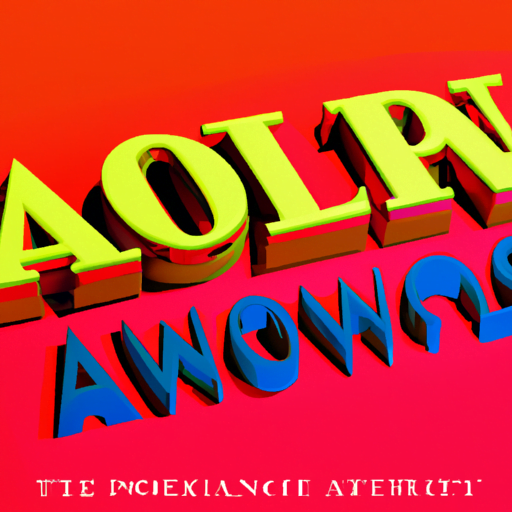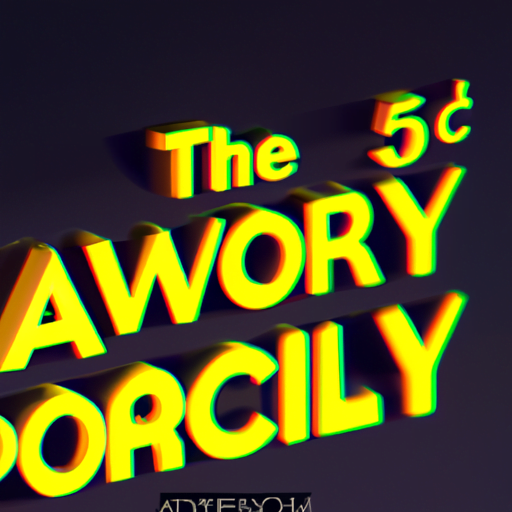
-
Table of Contents
- The Fascinating World of 3D Typography
- What is 3D Typography?
- The Evolution of 3D Typography
- Applications of 3D Typography
- 1. Advertising and Branding
- 2. Motion Graphics and Animation
- 3. Environmental and Exhibition Design
- The Impact of 3D Typography on Design and Communication
- 1. Enhanced Visual Appeal
- 2. Improved Brand Recognition
- 3. Increased Interactivity
- 4. Better Storytelling
- Conclusion
The Fascinating World of 3D Typography

Typography is an essential element of design that has evolved over the years. From traditional print to digital media, typography has taken on new dimensions and forms. One of the most captivating developments in typography is the emergence of 3D typography. This article explores the fascinating world of 3D typography, its applications, and the impact it has on design and communication.
What is 3D Typography?
3D typography is a technique that adds depth and dimension to traditional two-dimensional typography. It involves creating letterforms that appear three-dimensional, giving them a sense of volume and space. This technique allows designers to manipulate typography in ways that were previously impossible, resulting in visually striking and engaging designs.
Unlike traditional typography, which is limited to flat surfaces, 3D typography can be rendered in various materials and environments. It can be sculpted, extruded, or even animated, adding a new level of creativity and interactivity to design projects.
The Evolution of 3D Typography
3D typography has its roots in the early days of graphic design when designers experimented with perspective and shading to create the illusion of depth. However, it wasn’t until the advent of computer graphics and 3D modeling software that 3D typography truly took off.
With the rise of digital design tools, designers gained the ability to create intricate 3D letterforms with ease. This led to a surge in the popularity of 3D typography in various industries, including advertising, branding, and motion graphics.
Applications of 3D Typography
3D typography finds its applications in a wide range of design projects. Here are some notable examples:
1. Advertising and Branding
3D typography is often used in advertising and branding campaigns to create visually impactful and memorable designs. By adding depth and dimension to typography, designers can make their messages stand out and leave a lasting impression on viewers.
For example, the famous Coca-Cola logo has been rendered in 3D in various advertisements, giving it a sense of realism and making it more visually appealing.
2. Motion Graphics and Animation
3D typography is widely used in motion graphics and animation projects. By animating 3D letterforms, designers can bring them to life and create visually stunning effects. This technique is often employed in movie titles, commercials, and music videos.
One notable example is the opening sequence of the movie “The Great Gatsby,” where 3D typography is used to create a visually captivating introduction to the film.
3. Environmental and Exhibition Design
3D typography is also utilized in environmental and exhibition design to create immersive and interactive experiences. By incorporating 3D letterforms into physical spaces, designers can engage visitors and enhance the overall atmosphere of the environment.
For instance, the Museum of Ice Cream in New York City features vibrant 3D typography throughout its exhibits, adding a playful and whimsical touch to the visitor experience.
The Impact of 3D Typography on Design and Communication
3D typography has had a significant impact on design and communication. Here are some key ways in which it has influenced the industry:
1. Enhanced Visual Appeal
By adding depth and dimension to typography, 3D typography creates visually striking designs that capture attention and engage viewers. It allows designers to break free from the constraints of flat surfaces and explore new creative possibilities.
2. Improved Brand Recognition
3D typography can help brands stand out and be easily recognizable. By incorporating 3D letterforms into their logos and visual identity, companies can create a unique and memorable brand image.
3. Increased Interactivity
With the advent of augmented reality (AR) and virtual reality (VR) technologies, 3D typography has become even more interactive. Users can now interact with 3D letterforms in virtual environments, further enhancing the user experience and creating immersive brand experiences.
4. Better Storytelling
3D typography allows designers to convey messages and narratives more effectively. By manipulating letterforms in three dimensions, designers can create visual metaphors and communicate complex ideas in a more engaging and accessible way.
Conclusion
3D typography has revolutionized the world of design and communication. Its ability to add depth, dimension, and interactivity to typography has opened up new creative possibilities and enhanced the visual appeal of various design projects. From advertising and branding to motion graphics and environmental design, 3D typography has found its applications in a wide range of industries. As technology continues to advance, we can expect 3D typography to evolve further and continue to captivate audiences with its fascinating and immersive designs.
